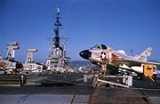
F4D Skyray
Encyclopedia
The Douglas F4D Skyray (later redesignated F-6 Skyray) was an American
carrier-based
supersonic fighter
/interceptor
built by the Douglas Aircraft Company
. Although it was in service for a relatively short time and never entered combat, it was notable for being the first carrier
-launched aircraft to hold the world's absolute speed record, at 752.943mph, and was the first United States Navy
and United States Marine Corps
fighter that could exceed Mach
1 in level flight. It was the last fighter produced by the Douglas Aircraft Company
before it merged with McDonnell Aircraft
and became McDonnell Douglas
. The F5D Skylancer was an advanced development of the F4D Skyray that did not go into service.
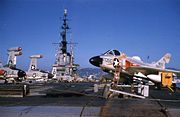 The Skyray was designed to meet a Navy requirement issued in 1947 for a fighter aircraft that could intercept and destroy an enemy aircraft at an altitude
The Skyray was designed to meet a Navy requirement issued in 1947 for a fighter aircraft that could intercept and destroy an enemy aircraft at an altitude
of 50,000 ft (15,240 m) within five minutes of the alarm being sounded. The Navy also wanted an aircraft that followed the designs and research of the German aerodynamicist Alexander Lippisch
, who moved to the U.S. after World War II
.
The F4D Skyray was a wide delta wing
design with long, sharply swept, rounded wings. The design was named for its resemblance to the Manta ray
fish. The thick wing roots contained the air intakes feeding a single turbojet engine. Fuel was contained both in the wings and the deep fuselage. Leading edge slats
were fitted for increased lift during takeoff and landing, while the trailing edges were mostly elevon
control surfaces. Additional pitch trimmers were fitted inboard near the jet exhaust, and were locked upward on takeoff and landing.
The Westinghouse J40
turbojet was the intended power plant, but Douglas took a conservative view and designed in contingency options for other power plants. The J40 proved troublesome and was eventually cancelled, with the Skyray was fitted instead with the Pratt & Whitney J57, a more powerful but larger engine.
Production aircraft were not delivered until early 1956, while the U.S. Marine Corps received their first in 1957. In total, 419 F4D-1 (later designated F-6 in the unified designation system
) aircraft were produced.
Its unique design also played a part in making the Skyray one of the best-known early jet
fighters. Affectionately known as the "Ford" (after the "Four" and "D" of its designation). In 1953, Edward H. Heinemann
was awarded the Collier Trophy
in recognition of his design work on the F4D.
 In April 1956, VC-3 was the first squadron operational with the F4D-1. This unit was later redesignated VFAW-3
In April 1956, VC-3 was the first squadron operational with the F4D-1. This unit was later redesignated VFAW-3
and assigned to NORAD, as the only U.S. Navy
fighter squadron in what was predominantly a U.S. Air Force and Royal Canadian Air Force
organization. VFAW-3 was permanently based at NAS North Island in San Diego, California
.
The U.S. Marine Corps
also flew the Skyray. When the Department of Defense
adopted a uniform aircraft designation system patterned on the USAF aircraft designation system in September 1962, the F4D was redesignated as the F-6A Skyray. In addition to multiple Navy and Marine Corps squadrons, Naval Air Reserve and Marine Air Reserve squadrons VF-881, VF-882 and VMF-215 also flew the Skyray. The last operational squadron was VMF(AW)-542, which flew the Skyray until February 1964.
The Skyray was designed exclusively for the high-altitude interception role with a spectacular rate and angle of climb. The Skyray set a new time to altitude record flying from a standing start to 49,221 ft (15,000 m) in 2 minutes and 36 seconds, all while flying at a 70° pitch angle. As a dedicated interceptor, the F4D was unsuited to the multi-mission capabilities soon in demand, so it had a short career in Navy and Marine Corps service, the last aircraft being withdrawn from service in 1964. Four aircraft were used by NACA
(soon to be NASA
) until 1969.
Under the new 1962 United States Tri-Service aircraft designation system
, the F4D-1 was redesignated the F-6A. The F4D (old designation) should not be confused with the F-4D (new designation) – the latter being the "D" variant of the McDonnell Douglas F-4 Phantom II operated by the U.S. Air Force.
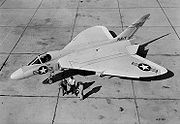 XF4D-1
XF4D-1
F4D-1
F4D-2
F4D-2N
YF-6A
F-6A
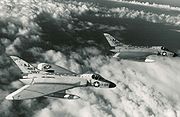
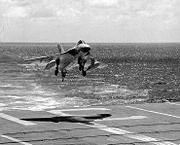
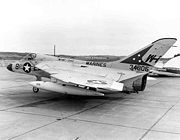

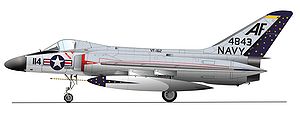
United States
The United States of America is a federal constitutional republic comprising fifty states and a federal district...
carrier-based
Carrier-based aircraft
Carrier-based aircraft are military aircraft designed specifically for operations from aircraft carriers. The term is generally applied only to fixed-wing aircraft, as naval helicopters are able to operate from a wider variety of aviation-capable ships. Carrier-based aircraft must be relatively...
supersonic fighter
Fighter aircraft
A fighter aircraft is a military aircraft designed primarily for air-to-air combat with other aircraft, as opposed to a bomber, which is designed primarily to attack ground targets...
/interceptor
Interceptor aircraft
An interceptor aircraft is a type of fighter aircraft designed specifically to prevent missions of enemy aircraft, particularly bombers and reconnaissance aircraft. Interceptors generally rely on high speed and powerful armament in order to complete their mission as quickly as possible and set up...
built by the Douglas Aircraft Company
Douglas Aircraft Company
The Douglas Aircraft Company was an American aerospace manufacturer, based in Long Beach, California. It was founded in 1921 by Donald Wills Douglas, Sr. and later merged with McDonnell Aircraft in 1967 to form McDonnell Douglas...
. Although it was in service for a relatively short time and never entered combat, it was notable for being the first carrier
Aircraft carrier
An aircraft carrier is a warship designed with a primary mission of deploying and recovering aircraft, acting as a seagoing airbase. Aircraft carriers thus allow a naval force to project air power worldwide without having to depend on local bases for staging aircraft operations...
-launched aircraft to hold the world's absolute speed record, at 752.943mph, and was the first United States Navy
United States Navy
The United States Navy is the naval warfare service branch of the United States Armed Forces and one of the seven uniformed services of the United States. The U.S. Navy is the largest in the world; its battle fleet tonnage is greater than that of the next 13 largest navies combined. The U.S...
and United States Marine Corps
United States Marine Corps
The United States Marine Corps is a branch of the United States Armed Forces responsible for providing power projection from the sea, using the mobility of the United States Navy to deliver combined-arms task forces rapidly. It is one of seven uniformed services of the United States...
fighter that could exceed Mach
Mach number
Mach number is the speed of an object moving through air, or any other fluid substance, divided by the speed of sound as it is in that substance for its particular physical conditions, including those of temperature and pressure...
1 in level flight. It was the last fighter produced by the Douglas Aircraft Company
Douglas Aircraft Company
The Douglas Aircraft Company was an American aerospace manufacturer, based in Long Beach, California. It was founded in 1921 by Donald Wills Douglas, Sr. and later merged with McDonnell Aircraft in 1967 to form McDonnell Douglas...
before it merged with McDonnell Aircraft
McDonnell Aircraft
The McDonnell Aircraft Corporation was an American aerospace manufacturer based in St. Louis, Missouri. The company was founded on July 16, 1939 by James Smith McDonnell, and was best known for its military fighters, including the F-4 Phantom II, and manned spacecraft including the Mercury capsule...
and became McDonnell Douglas
McDonnell Douglas
McDonnell Douglas was a major American aerospace manufacturer and defense contractor, producing a number of famous commercial and military aircraft. It formed from a merger of McDonnell Aircraft and Douglas Aircraft in 1967. McDonnell Douglas was based at Lambert-St. Louis International Airport...
. The F5D Skylancer was an advanced development of the F4D Skyray that did not go into service.
Design and development

Altitude
Altitude or height is defined based on the context in which it is used . As a general definition, altitude is a distance measurement, usually in the vertical or "up" direction, between a reference datum and a point or object. The reference datum also often varies according to the context...
of 50,000 ft (15,240 m) within five minutes of the alarm being sounded. The Navy also wanted an aircraft that followed the designs and research of the German aerodynamicist Alexander Lippisch
Alexander Lippisch
Alexander Martin Lippisch was a German pioneer of aerodynamics. He made important contributions to the understanding of flying wings, delta wings and the ground effect. His most famous design is the Messerschmitt Me 163 rocket-powered interceptor.Lippisch was born in Munich, Kingdom of Bavaria...
, who moved to the U.S. after World War II
World War II
World War II, or the Second World War , was a global conflict lasting from 1939 to 1945, involving most of the world's nations—including all of the great powers—eventually forming two opposing military alliances: the Allies and the Axis...
.
The F4D Skyray was a wide delta wing
Delta wing
The delta wing is a wing planform in the form of a triangle. It is named for its similarity in shape to the Greek uppercase letter delta .-Delta-shaped stabilizers:...
design with long, sharply swept, rounded wings. The design was named for its resemblance to the Manta ray
Manta ray
The manta ray is the largest species of the rays. The largest known specimen was more than across, with a weight of about . It ranges throughout waters of the world, typically around coral reefs...
fish. The thick wing roots contained the air intakes feeding a single turbojet engine. Fuel was contained both in the wings and the deep fuselage. Leading edge slats
Leading edge slats
Slats are aerodynamic surfaces on the leading edge of the wings of fixed-wing aircraft which, when deployed, allow the wing to operate at a higher angle of attack. A higher coefficient of lift is produced as a result of angle of attack and speed, so by deploying slats an aircraft can fly at slower...
were fitted for increased lift during takeoff and landing, while the trailing edges were mostly elevon
Elevon
Elevons are aircraft control surfaces that combine the functions of the elevator and the aileron , hence the name. They are frequently used on tailless aircraft such as flying wings. An elevon that is not part of the main wing, but instead is a separate tail surface, is a stabilator...
control surfaces. Additional pitch trimmers were fitted inboard near the jet exhaust, and were locked upward on takeoff and landing.
The Westinghouse J40
Westinghouse J40
|-References:...
turbojet was the intended power plant, but Douglas took a conservative view and designed in contingency options for other power plants. The J40 proved troublesome and was eventually cancelled, with the Skyray was fitted instead with the Pratt & Whitney J57, a more powerful but larger engine.
Production aircraft were not delivered until early 1956, while the U.S. Marine Corps received their first in 1957. In total, 419 F4D-1 (later designated F-6 in the unified designation system
1962 United States Tri-Service aircraft designation system
The 1962 United States Tri-Service aircraft designation system is a unified designation system introduced by the United States Department of Defense on 18 September 1962 for all the U.S. military aircraft. Prior to this date, each armed service used their own nomenclature system...
) aircraft were produced.
Its unique design also played a part in making the Skyray one of the best-known early jet
Jet aircraft
A jet aircraft is an aircraft propelled by jet engines. Jet aircraft generally fly much faster than propeller-powered aircraft and at higher altitudes – as high as . At these altitudes, jet engines achieve maximum efficiency over long distances. The engines in propeller-powered aircraft...
fighters. Affectionately known as the "Ford" (after the "Four" and "D" of its designation). In 1953, Edward H. Heinemann
Ed Heinemann
Edward Henry Heinemann, was a noted military aircraft designer for Douglas Aircraft Company.-Biography:...
was awarded the Collier Trophy
Collier Trophy
The Collier Trophy is an annual aviation award administered by the U.S. National Aeronautics Association , presented to those who have made "the greatest achievement in aeronautics or astronautics in America, with respect to improving the performance, efficiency, and safety of air or space...
in recognition of his design work on the F4D.
Operational history

VFAW-3
VFAW-3 All Weather Fighter Squadron 3 of the US Navy was active in the 1950's. It was the only Navy unit in North American Air Defense Command with assignment to detect and defend enemy aircraft approaching Alaska, Canada, and the lower United States. VFAW-3 was decommissioned in April 1963...
and assigned to NORAD, as the only U.S. Navy
United States Navy
The United States Navy is the naval warfare service branch of the United States Armed Forces and one of the seven uniformed services of the United States. The U.S. Navy is the largest in the world; its battle fleet tonnage is greater than that of the next 13 largest navies combined. The U.S...
fighter squadron in what was predominantly a U.S. Air Force and Royal Canadian Air Force
Royal Canadian Air Force
The history of the Royal Canadian Air Force begins in 1920, when the air force was created as the Canadian Air Force . In 1924 the CAF was renamed the Royal Canadian Air Force and granted royal sanction by King George V. The RCAF existed as an independent service until 1968...
organization. VFAW-3 was permanently based at NAS North Island in San Diego, California
San Diego, California
San Diego is the eighth-largest city in the United States and second-largest city in California. The city is located on the coast of the Pacific Ocean in Southern California, immediately adjacent to the Mexican border. The birthplace of California, San Diego is known for its mild year-round...
.
The U.S. Marine Corps
United States Marine Corps
The United States Marine Corps is a branch of the United States Armed Forces responsible for providing power projection from the sea, using the mobility of the United States Navy to deliver combined-arms task forces rapidly. It is one of seven uniformed services of the United States...
also flew the Skyray. When the Department of Defense
United States Department of Defense
The United States Department of Defense is the U.S...
adopted a uniform aircraft designation system patterned on the USAF aircraft designation system in September 1962, the F4D was redesignated as the F-6A Skyray. In addition to multiple Navy and Marine Corps squadrons, Naval Air Reserve and Marine Air Reserve squadrons VF-881, VF-882 and VMF-215 also flew the Skyray. The last operational squadron was VMF(AW)-542, which flew the Skyray until February 1964.
The Skyray was designed exclusively for the high-altitude interception role with a spectacular rate and angle of climb. The Skyray set a new time to altitude record flying from a standing start to 49,221 ft (15,000 m) in 2 minutes and 36 seconds, all while flying at a 70° pitch angle. As a dedicated interceptor, the F4D was unsuited to the multi-mission capabilities soon in demand, so it had a short career in Navy and Marine Corps service, the last aircraft being withdrawn from service in 1964. Four aircraft were used by NACA
National Advisory Committee for Aeronautics
The National Advisory Committee for Aeronautics was a U.S. federal agency founded on March 3, 1915 to undertake, promote, and institutionalize aeronautical research. On October 1, 1958 the agency was dissolved, and its assets and personnel transferred to the newly created National Aeronautics and...
(soon to be NASA
NASA
The National Aeronautics and Space Administration is the agency of the United States government that is responsible for the nation's civilian space program and for aeronautics and aerospace research...
) until 1969.
Under the new 1962 United States Tri-Service aircraft designation system
1962 United States Tri-Service aircraft designation system
The 1962 United States Tri-Service aircraft designation system is a unified designation system introduced by the United States Department of Defense on 18 September 1962 for all the U.S. military aircraft. Prior to this date, each armed service used their own nomenclature system...
, the F4D-1 was redesignated the F-6A. The F4D (old designation) should not be confused with the F-4D (new designation) – the latter being the "D" variant of the McDonnell Douglas F-4 Phantom II operated by the U.S. Air Force.
F5D Skylancer
The F5D Skylancer was derived from the F4D and intended to be a Mach 2 capable successor to the Skyray. Although four prototypes were built and flown, the project was cancelled as being too similar in mission parameters to the Vought F8U Crusader and also to reduce dependence upon Douglas Aircraft, which was also producing several other aircraft for the U.S. Navy.Variants

- Prototypes, redesignated YF-6A in 1962, two built
F4D-1
- Single-seat fighter aircraft, production model redesignated F-6A in 1962, 420 built.
F4D-2
- Re-engined F4D-1 with the J57-F-14, 100 on order cancelled.
F4D-2N
- F4D-2 version with extended nose housing twin radar scanners, project only evolved into the F5D SkylancerF5D Skylancer|-See also:-References:NotesBibliography* Angelucci, Enzo. The American Fighter. Sparkford, Somerset, UK: Haynes Publishing Group, 1987. ISBN 0-85429-635-2....
.
YF-6A
- XF4D-1 prototypes redesignated in 1962.
F-6A
- F4D-1 redesignated in 1962.
Operators



-
- US Navy
- VFAW-3VFAW-3VFAW-3 All Weather Fighter Squadron 3 of the US Navy was active in the 1950's. It was the only Navy unit in North American Air Defense Command with assignment to detect and defend enemy aircraft approaching Alaska, Canada, and the lower United States. VFAW-3 was decommissioned in April 1963...
- VF-13
- VF-21VF-21Fighter Squadron 21 Freelancers was an aviation unit of the United States Navy originally established in 1944 as VF-81. It was disestablished in 1996.-History:...
- VF-23
- VF-51VF-51VF-51, Fighter Squadron 51 was an aviation unit of the United States Navy known as the "Screaming Eagles". The squadron established in 1943 and retired and its personnel reassigned in 1995.- History :...
- VF-74VF-74VF-74, Fighter Squadron 74, Be-Devilers was an aviation unit of the United States Navy in service from 1944 to 1994.-History:VF-74 was established on 16 April 1945 as VBF-20 flying the F4U-1 Corsair from NAS Wildwood in New Jersey. After six months they transitioned to the F6F Hellcat but soon...
- VF-101VF-101Fighter Squadron 101, also known as VF-101 and the Grim Reapers, was a United States Navy F-14 Fleet Replacement Squadron based at Naval Air Station Oceana until disestablishment in 2005...
- VF-102
- VF-141
- VF-162
- VF-213
- VF-881
- VF-882
-
- US Marines
- VMF-113VMF-113Marine Fighter Squadron 113 was a fighter squadron of the United States Marine Corps during World War II and in the Marine Forces Reserve until 1965. Known as the "Whistling Devils", the squadron participated in aerial combat over the Marshall Islands in 1944 and took part in the Battle of...
- VMF-114
- VMF-115
- VMF-215VMF-215Marine Fighting Squadron 215 was a fighter squadron of the United States Marine Corps that was activated and fought during World War II. Known as "The Fighting Corsairs", they fought in many areas of the Pacific War, including the Battle of Bougainville...
- VMF-314
- VMF-513
- VMFA-531VMFA-531Marine Fighter Attack Squadron 531 was a United States Marine Corps fighter squadron consisting of F/A-18 Hornets . Known as the "Grey Ghosts”, the squadron participated in action during World War II and the Vietnam War...
- VMF(AW)-542
-
- NACA /NASA
Survivors

- The sole-surviving XF4D-1 (BuNo 124587) is on loan from the National Museum of Naval Aviation and is display at the U.S. Naval Museum of Armament and Technology at NAWS China Lake, California.
- An F4D-1 (BuNo 134806) is part of the collection preserved at the National Museum of Naval AviationNational Museum of Naval AviationThe National Museum of Naval Aviation is a military and aerospace museum located at Naval Air Station Pensacola, Florida. The museum opened in 1962....
at NAS Pensacola, Florida - F4D-1 (BuNo 134748) is on loan from the National Museum of Naval Aviation and is on display at the Pima Air and Space Museum in Tucson, ArizonaTucson, ArizonaTucson is a city in and the county seat of Pima County, Arizona, United States. The city is located 118 miles southeast of Phoenix and 60 miles north of the U.S.-Mexico border. The 2010 United States Census puts the city's population at 520,116 with a metropolitan area population at 1,020,200...
. - F4D-1 (BuNo 134936) is part of the collection at the Pueblo Weisbrod Aircraft MuseumPueblo Weisbrod Aircraft MuseumThe Pueblo Weisbrod Aircraft Museum is a combination of the Weisbrod Museum and the International B-24 Memorial Museum, designed to honor the men and women who served during World War II with emphasis on the Pueblo Army Air Base and the B-24 Liberator bomber...
- F4D-1 (BuNo 134836) is on outdoor display at the New England Air MuseumNew England Air MuseumThe New England Air Museum is located at Bradley International Airport, Windsor Locks, Connecticut, USA. The museum is housed in three large display buildings consisting of more than of exhibit space...
in Windsor Locks, Connecticut. - F4D-1 (BuNo 139177) is on loan from the National Museum of Naval Aviation and on display at the Flying Leatherneck Aviation Museum at MCAS Miramar in
San Diego, California. - F4D-1 (BuNo 134950) is on loan from the National Museum of Naval Aviation and is on display at Aviation Heritage Park at NAS Oceana in Virginia Beach, Virginia.
- F4D-1 (BuNo 134764) is on outdoor display at Naval Air Station Patuxent RiverNaval Air Station Patuxent River"Pax River" redirects here. For the river, see Patuxent River.Naval Air Station Patuxent River , also known as NAS Pax River, is a United States Naval Air Station located in St. Mary's County, Maryland on the Chesapeake Bay near the mouth of the Patuxent River. It is home to the U.S...
in St. Mary's County, Maryland.
Specifications (F4D-1)


